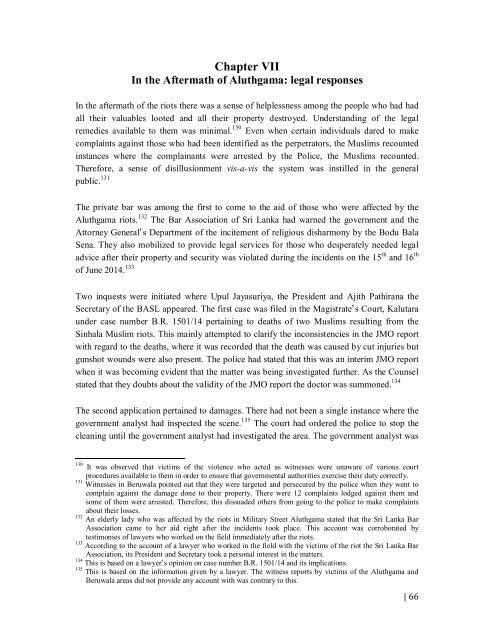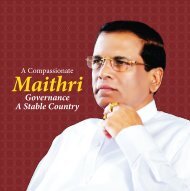You also want an ePaper? Increase the reach of your titles
YUMPU automatically turns print PDFs into web optimized ePapers that Google loves.
Chapter VII<br />
In the Aftermath of Aluthgama: legal responses<br />
In the aftermath of the riots there was a sense of helplessness among the people who had had<br />
all their valuables looted and all their property destroyed. Understanding of the legal<br />
remedies available to them was minimal. 130 Even when certain individuals dared to make<br />
complaints against those who had been identified as the perpetrators, the Muslims recounted<br />
instances where the complainants were arrested by the Police, the Muslims recounted.<br />
Therefore, a sense of disillusionment vis-a-vis the system was instilled in the general<br />
public. 131<br />
The private bar was among the first to come to the aid of those who were affected by the<br />
Aluthgama riots. 132 The Bar Association of Sri Lanka had warned the government and the<br />
Attorney General’s Department of the incitement of religious disharmony by the Bodu Bala<br />
Sena. They also mobilized to provide legal services for those who desperately needed legal<br />
advice after their property and security was violated during the incidents on the 15 th and 16 th<br />
of June 2014. 133<br />
Two inquests were initiated where Upul Jayasuriya, the President and Ajith Pathirana the<br />
Secretary of the BASL appeared. The first case was filed in the Magistrate’s Court, Kalutara<br />
under case number B.R. 1501/14 pertaining to deaths of two Muslims resulting from the<br />
Sinhala Muslim riots. This mainly attempted to clarify the inconsistencies in the JMO <strong>report</strong><br />
with regard to the deaths, where it was recorded that the death was caused by cut injuries but<br />
gunshot wounds were also present. The police had stated that this was an interim JMO <strong>report</strong><br />
when it was becoming evident that the matter was being investigated further. As the Counsel<br />
stated that they doubts about the validity of the JMO <strong>report</strong> the doctor was summoned. 134<br />
The second application pertained to damages. There had not been a single instance where the<br />
government analyst had inspected the scene. 135 The court had ordered the police to stop the<br />
cleaning until the government analyst had investigated the area. The government analyst was<br />
130 It was observed that victims of the violence who acted as witnesses were unaware of various court<br />
procedures available to them in order to ensure that governmental authorities exercise their duty correctly.<br />
131 Witnesses in Beruwala pointed out that they were targeted and persecuted by the police when they went to<br />
complain against the damage done to their property. There were 12 complaints lodged against them and<br />
some of them were arrested. Therefore, this dissuaded others from going to the police to make complaints<br />
about their losses.<br />
132 An elderly lady who was affected by the riots in Military Street Aluthgama stated that the Sri Lanka Bar<br />
Association came to her aid right after the incidents took place. This account was corroborated by<br />
testimonies of lawyers who worked on the field immediately after the riots.<br />
133 According to the account of a lawyer who worked in the field with the victims of the riot the Sri Lanka Bar<br />
Association, its President and Secretary took a personal interest in the matters.<br />
134 This is based on a lawyer’s opinion on case number B.R. 1501/14 and its implications.<br />
135 This is based on the information given by a lawyer. The witness <strong>report</strong>s by victims of the Aluthgama and<br />
Beruwala areas did not provide any account with was contrary to this.<br />
| 66




